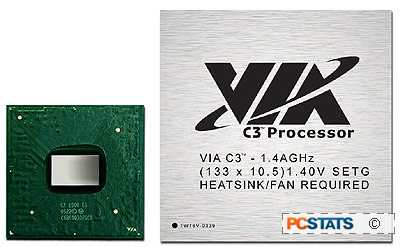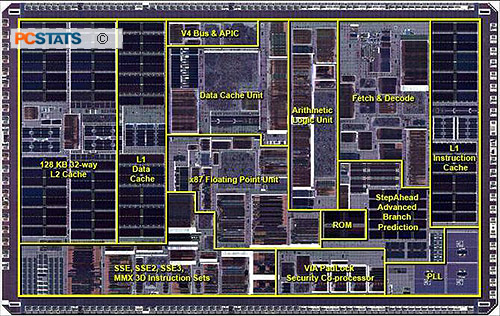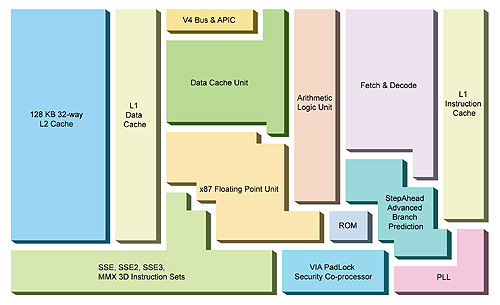According to VIA, when released the C7-M processor will
be extremely cool-running and easy on battery life. The TDP of the processor is
a mere 20W for a 2.0GHz unit and 16W for a 1.6GHZ unit, as compared to the 27W
that a 1.8GHZ Intel Pentium M processor outputs.  That's cool enough, but VIA's
PowerSaver technology should continue to dynamically reduce processor speed and voltage
based on current requirements, further reducing power requirements and heat.
That's cool enough, but VIA's
PowerSaver technology should continue to dynamically reduce processor speed and voltage
based on current requirements, further reducing power requirements and heat.
The average power consumption of the
C7-M processor is said to be less than 1Watt, though 'average' used in this sense is
a fairly arbitrary value. Minimum power consumption is an
infinitesimal 0.1Watt, which is impressive.
PowerSaver is VIA's nomenclature for its
dynamic underclocking technology. The VIA C7-M uses PowerSaver to reduce
processor speed on the fly, conserving power. We assume this feature goes
hand-in-hand with the 'Twin-Turbo' dual PLL (Phase Lock Loop) system the
processor uses. PLLs are used to synchronize the processor speed to the
data stream, so each PLL could be set to a different multiplier setting, one
normal, one slower (and less power hungry). Switching between the two is
an easy (and fast) method of reducing CPU speed when it's not needed.
The tiny size and BGA packaging of the VIA C7-M processor also help it
shed heat quickly, meaning that few elaborate cooling mechanisms should be necessary,
even in tiny ultra portable laptops.
Performance
Characteristics
The VIA C7-M processor uses a 16-unit execution
pipeline like its C3-M predecessor. It also features a large 128K of L1
cache memory and a comparatively meagre 128K of L2 cache memory, both figures
being double that of the C3 line of processors. 128KB of L2 cache
memory is practically non-existant when compared to the 1MB or 2MB caches
used by the Intel and AMD competition, and unfortunately; the meager L2 cache size
of the VIA C3 processor went a long way towards explaining its
poor performance in CPU intensive benchmarks. It's looking like the VIA C7-M may
suffer from the same problems.... Before we pass early judgements though, let's
take a look at some of the positive performance features that VIA has added to
this processor to boost its performance.

VIA has enabled support for SSE2 and SSE3 in the
VIA C7-M, which should help its performance considerably in some applications. Better
yet, VIA's V4 DDR memory bus is now supported, which will eventually
boost the FSB speed from the 200MHz used by the VIA C3 to a modern and
entirely respectable 800MHz. The first iterations of the VIA C7-M will use either
a 400MHz or 533MHz FSB powered by DDR and/or DDR2 memory. VIA has made
a commitment to supporting DDR2 with the VIA C7 line of processors, paralleling
Intel's approach.

Though it's primarily a
power-saving feature, the VIA Twin-Turbo technology incorporated into the C7-M
will also boost mobile performance. Having dual PLL (Phase Lock Loop)
clocks allows the processor to quickly switch between a low-power, low-speed
idle state and full operation, simply by switching which clock is being used to
synchronize the processor. One PLL has a lower multiplier, while the other
uses the full normal speed of the processor, and switching between them takes
less time than adjusting a single PLL by other means would. This should
allow the C7 to avoid the performance 'stutters' common to notebook processors
with power saving modes.
Overall, expecting the VIA C7-M processor to compete directly with Intel Pentium-M
and AMD Turion processors in performance is unreasonable and unlikely.
VIA has claimed that the C7-M is about "15% more powerful per Watt than
an Intel Pentium-M," on average. Reading between the lines, we'd expect a
VIA C7-M processor to deliver about 65% of the performance of an Intel Pentium-M
CPU in mixed and gaming benchmarks, though the two processors
should be a lot closer together in encryption/decryption tasks that
are covered by the VIA C7-M's Padlock security Co-Processor.
